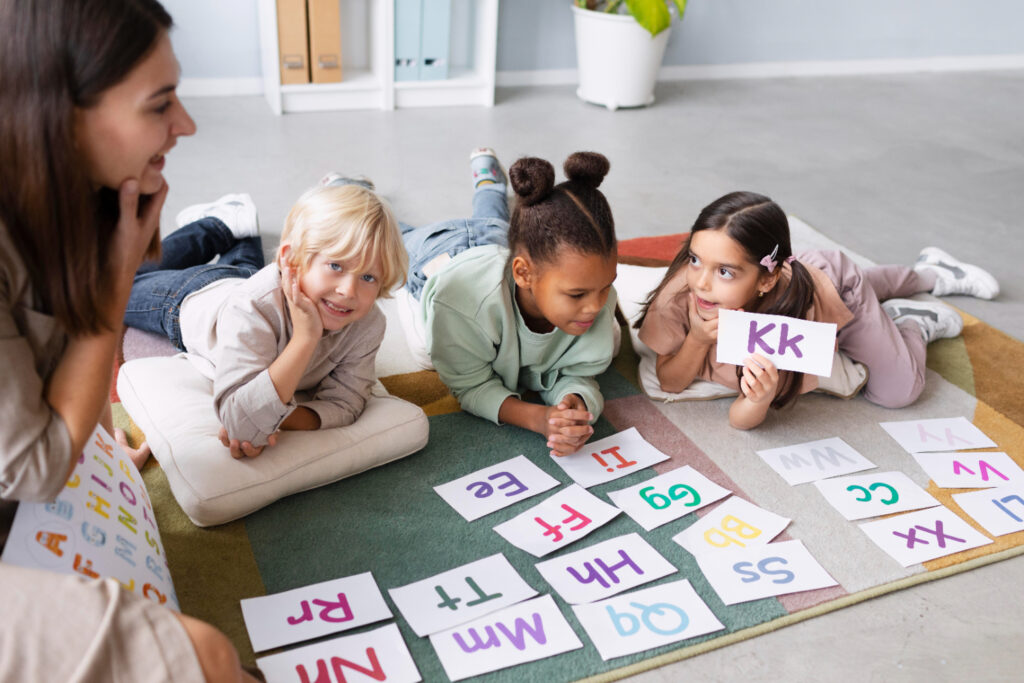Building a child’s vocabulary is one of the most impactful ways to improve their reading comprehension and overall literacy.
Strong vocabulary skills allow children to better understand what they read, communicate more effectively, and think critically. While expanding a child’s vocabulary may seem like a challenging task, there are several effective techniques that can make the process enjoyable and impactful.
Here are seven powerful methods for teaching new words to children, helping to lay the foundation for their future academic success.
Reading Aloud
Reading aloud to children offers one of the most effective ways to introduce new words. Hearing stories provides a natural context for vocabulary acquisition, as children encounter words they may not hear in everyday conversation.
During read-aloud sessions, pausing to introduce and discuss new words helps deepen their understanding. It’s helpful to explain these words in ways that connect to the child’s experiences or other words they already know.
Interactive discussions during read-alouds further enhance vocabulary learning.
Asking children questions like, “What do you think this word means?” encourages active thinking. Reading aloud also creates opportunities for repetition, allowing children to hear new words multiple times within the same text, which reinforces retention.
Word Walls
Word walls serve as an excellent visual aid for helping children remember new words.
Creating a word wall involves placing key vocabulary words on a prominent display in a classroom or at home. These walls allow children to see the words on a regular basis, making them more likely to use them in conversation and writing.
Maintaining an effective word wall requires consistent updates. Organizing words by theme, subject, or first letter makes them easier for children to locate. Reviewing the wall frequently and encouraging children to interact with the words by using them in sentences or drawing pictures that represent them further strengthens retention. Word walls provide a visual and hands-on experience for learning vocabulary.
Using Context Clues
Teaching children to use context clues is a vital skill that helps them unlock the meaning of unfamiliar words without needing to stop and ask for definitions. When children encounter a new word in a sentence, context clues—like the surrounding words or sentences—can help them infer its meaning. For example, the sentence “The scorching sun made the day unbearably hot” provides a clue about the word “scorching.”
Context clues come in various forms, such as definitions, which provide the meaning of a word in the sentence, examples, which relate to the new word, and contrasts, which compare the unfamiliar word with something familiar. Practicing this skill helps children become more independent readers and builds their confidence in tackling new vocabulary.
Root Words, Prefixes, and Suffixes
Breaking words down into their root components is a powerful strategy for teaching vocabulary.
Many words share common roots, prefixes, and suffixes, which can provide clues about their meanings. For example, understanding that “bio” refers to life and “graph” refers to writing makes it easier for children to understand the meaning of words like “biography.”
Teaching children morphemic analysis helps them decode unfamiliar words and fosters long-term vocabulary growth. Providing examples of common prefixes like “un-” (meaning not) or suffixes like “-ly” (indicating how something is done) helps children understand how word parts function together. Practicing this skill equips children with the tools to approach new words confidently.
Vocabulary Games and Activities
Learning new words becomes enjoyable and engaging through interactive games and activities.
Simple games like “Word Bingo” or “Vocabulary Jeopardy” encourage children to practice using new words in a playful setting. Another effective activity is creating vocabulary flashcards in which children can write the word on one side and its definition or picture on the other.
Word puzzles, crosswords, and word searches also keep vocabulary learning enjoyable. Children reinforce their understanding of new words through games, but they also begin to associate vocabulary learning with fun, making them more eager to learn.
Vocabulary Journals
Vocabulary journals offer children a space to document and review new words. Writing down new words and their meanings, along with sentences or pictures that illustrate their understanding, helps solidify the words in their memory.
These journals act as a personal vocabulary collection that children can revisit, expanding their knowledge over time.
Encouraging children to use their vocabulary journals during independent reading or class discussions strengthens their ability to recall and apply new words. Keeping these journals structured and organized, with space for definitions, examples, and connections to other words, makes them a valuable tool for long-term vocabulary development.
Real-World Connections
Connecting new words to real-life experiences enhances their relevance and meaning. When children can relate a new word to something tangible in their world, they are more likely to remember it. For example, introducing the word “habitat” during a visit to a zoo or park creates a memorable connection between the word and the child’s experience of seeing animals in their environments.
Encouraging children to observe and apply new vocabulary in daily life also helps them see the practical value of learning new words.
During conversations, drawing attention to opportunities where a recently learned word fits can deepen the child’s understanding and make the learning process more engaging.
Speak with a Reading Expert
Expanding a child’s vocabulary plays an essential role in their overall literacy development.
Techniques such as reading aloud, using word walls, and practicing context clues not only help children learn new words, but also make the process of vocabulary acquisition fun and meaningful. By employing these seven effective strategies, parents and educators can foster a rich language environment that supports a child’s growth as a confident and capable reader.
Incorporating these methods into daily reading instruction can have a significant impact on vocabulary retention and overall reading comprehension. Contact Read Smart today for expert guidance on developing your child’s vocabulary skills.
Our team of reading experts can provide personalized strategies to help your child succeed in reading and beyond. Empower your child with the tools they need to become lifelong learners and avid readers.

